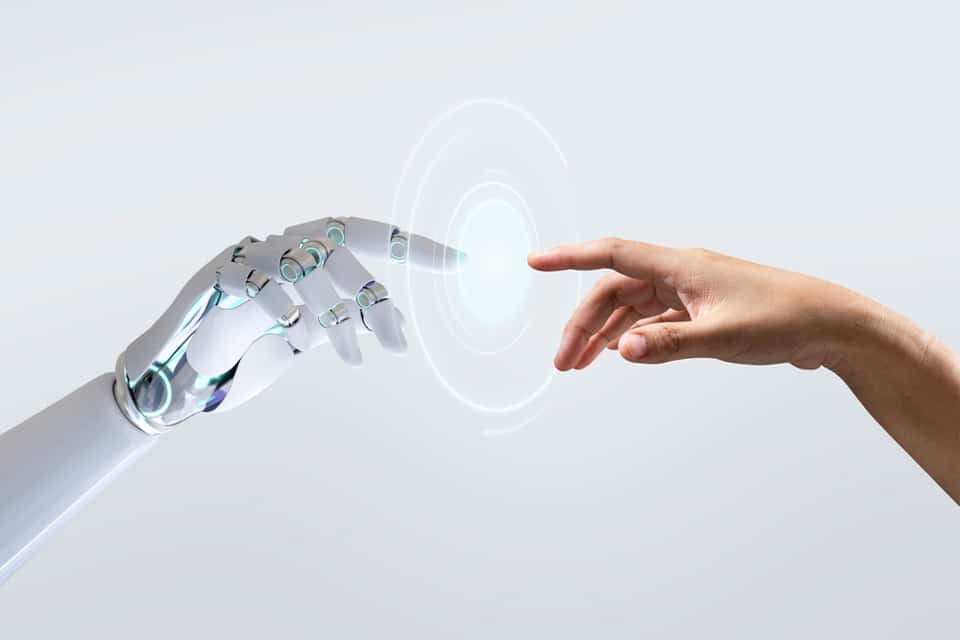
In late 2023, a blog post by Bill Gates predicted that we might be less than 2 years away from AI technology becoming the new norm for everyday life in highly developed countries. Now more than halfway through 2024, it’s clear that this prediction wasn’t just blind stipulation; AI is here to stay, and it’s growing more and more with each passing year. What could this mean for the future of AI in digital marketing?
AI technology has made massive advances over the past few years– and they’re hard to ignore. AI can automate time-consuming tasks and consistently produce high-quality content in a short period of time, making it a truly transformative technology in a variety of industries. Digital marketing is just one of many industries that are set to be totally transformed by automation.
The digital marketing industry is made up of various smaller industries, each of them working together to promote their clients. With AI usage rapidly increasing as the industry continues to evolve, key industries like writing, graphic design, and even web development are bound to be affected in ways we’ve never seen before.
AI and Writing in Digital Marketing

Text-based AI like ChatGPT specialize in generating text, usually with limited or no capacity to create sound or images. Additionally, advanced natural language processing (NPL) algorithms allow these programs to quickly edit text, summarize essays, and even generate short written pieces from just a single prompt. What does automation mean for writers in the digital marketing industry?
Pros of AI in Writing
Efficiency: AI programs like ChatGPT can quickly generate writing for all kinds of content, from social media captions to long-form essays. With its built-in proficiency for writing, editing, and proofreading, AI can cut down the amount of time it takes for writers to finish their work. A well-worded prompt can also provide inspiration for writers who suffer from writer’s block, acting as a nearly endless source of inspiration.
Consistency: If you regularly interact with or use AI for writing, you might notice that many of them have a distinct and consistent writing style. AI programs are often trained on existing work, which they use to assemble the content they generate according to the prompt given by the user. By processing all this knowledge, AI have been trained to write in a consistent tone and style that can be used across various platforms.
Cons of AI in Writing
Lack of Creativity: Writing is a highly creative process, and creativity can be hard to come by–even for humans. Although AI programs are trained on basic spelling, grammar, and linguistic conventions, any writing you get from an AI is consistent to a fault, lacking in human nuance and creativity. This is why AI usage is often encouraged as a tool for inspiration, rather than a replacement for actual writing skills.
Ethical Concerns: As previously established, AI programs are trained using the existing works of human writers. These works could come from anywhere, from peer-reviewed research papers to blog posts, or even unsuspecting users’ social media captions. This raises its fair share of questions from users who are concerned about the privacy of their online content. Moreover, programs like ChatGPT could potentially allow students to cheat on written assignments, giving rise to concerns about plagiarism in academic and professional settings.
AI and Graphic Design in Digital Marketing

Generative AI is forever changing how artists and graphic designers work through the creative process. Tools like Adobe Photoshop, Canva, and Click-Up incorporate AI into their editing software, allowing creators to refine their images with just the click of a button. Most impressively, these programs are also capable of generating fully rendered, (mostly) high-quality images in a matter of seconds. Such advanced tech may seem too good to be true– but for many artists, it can be both a blessing and a curse.
Pros of AI in Graphic Design
Efficient Accessibility: Generative AI allows for quick and seamless editing in programs like Photoshop, allowing designers to experiment with different edits while saving time and money. Moreover, these programs are widely and publicly available for anyone to use. This could open doors to people who lack the ability to draw or design high-quality images for accessibility reasons.
Personalized Ideas: Like text-based programs, AI art programs learn by analyzing and collecting data from existing images, usually from search engines or social media sites like Instagram or X (formerly Twitter). With such a wide range of data available, generative AI can create highly personalized images or design elements based on the user’s specific needs. This finely tuned personalization, combined with the speed at which these can create images, makes generative AI a truly powerful tool for coming up with unique ideas in very little time.
Cons of AI in Graphic Design
Inconsistent Quality: At first glance, AI-generated images seem polished and high quality; however, keen-eyed viewers may be quick to notice their many inconsistencies and strange visual glitches. These glitches may include a lack of fine detail, overly polished art style, and– perhaps most famously– difficulty drawing hands. Thanks to these consistent mistakes, many viewers can reliably differentiate AI-generated images from real drawings or photographs.
More Ethical Concerns: The conflict between artists and AI users has been ongoing since the popularization of image generation, when AI-generated images became widespread on social media platforms. The method by which AI are trained gave rise to concerns about visual plagiarism; many artists worry that their work may be used to train AI and copy their style, despite the artists never giving them consent to do so. Furthermore, the usage of AI-generated images in digital marketing and other professional contexts could endanger many jobs in the graphic design industry.
AI and Web Design in Digital Marketing

Programmers and web designers are now turning to AI for assistance with writing, testing, and proofreading their code. To keep up, tools like GitHub Copilot are incorporating AI-driven tech into the coding process to help programmers work more quickly and accurately.
Pros of AI in Web Design
Productivity and Error Reduction: When it comes to programming, AI can take advantage of the highly semantic and rule-based format of coding languages. AI programs are able to rapidly generate and proofread code in a variety of languages, making it capable of completing tasks much more efficiently than the average human programmer. Of course, AI-written code won’t suffice on its own without human input; however, as a supplementary tool, AI could elevate web designers to new levels of efficiency without sacrificing accuracy.
Innovative Solutions: Because coding is highly focused on problem-solving and rule-based logic, human error has almost always been a factor in web design– until now, that is. AI programs are capable of analyzing problems in a far more complex and in-depth manner than most humans can; as such, they are capable of producing a greater number of potential solutions. It’s entirely possible that an AI could present new and innovative solutions to problems that humans haven’t even begun to solve.
Cons of AI in Web Design
Complex Code (“What Do I Do With This?”): Although AI-generated code might be more efficient to create, that still leaves the human developer to figure out how to integrate said code into their own projects. AI-generated code might be more difficult for developers to understand, or it may cause errors if the code is incompatible with what has already been developed. This leaves developers with the additional task of rewriting the AI-generated code to fit their website’s needs, which may defeat the purpose of automated code generation.
Privacy and Security Risks: According to a 2023 survey, over 50% of businesses that used AI-generated code on their websites ran into security issues later down the line as a direct result. When an AI runs code completion for a significant portion of a company’s website, it is highly unlikely that the organization’s security protocols are taken into account. These flaws may leave crucial portions of the website open to malicious actors who could take advantage of these vulnerabilities, potentially compromising important company operations or sensitive user information.
The Future of AI in Digital Marketing
In less than two years, AI has already changed the digital landscape in ways no one could have predicted. This truth is becoming increasingly apparent as industries across the world continue to take advantage of AI-driven automation. However, with the rise of AI already reaching unprecedented heights, human input has become that much more important for avoiding ethical and quality-related concerns.
As a combination of many different and highly creative industries, digital marketing firms like iStudios Media are in a unique position to take advantage of advancements in AI. However, it’s just as important to remember that marketing is, first and foremost, a people-first practice. To use AI in a safe and ethical manner, real people should always be a part of the process from start to finish.




